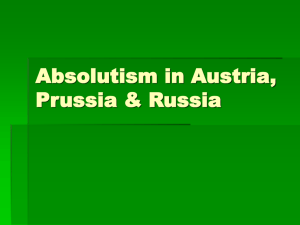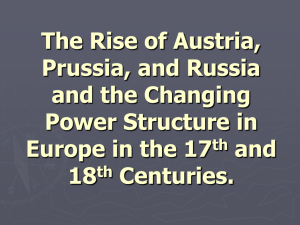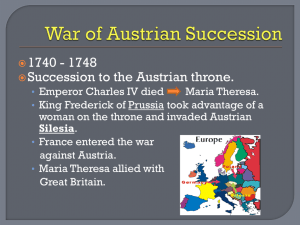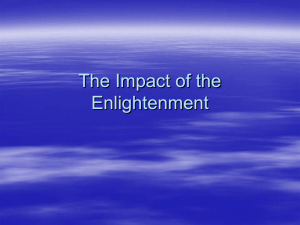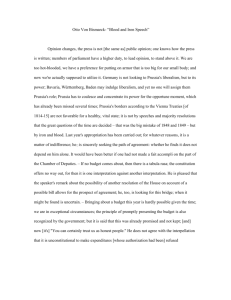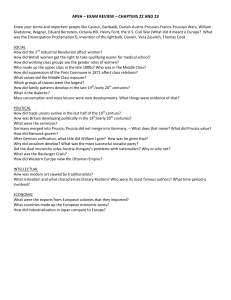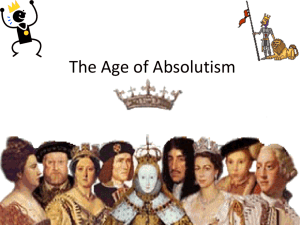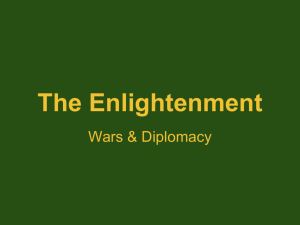View Presentation
advertisement
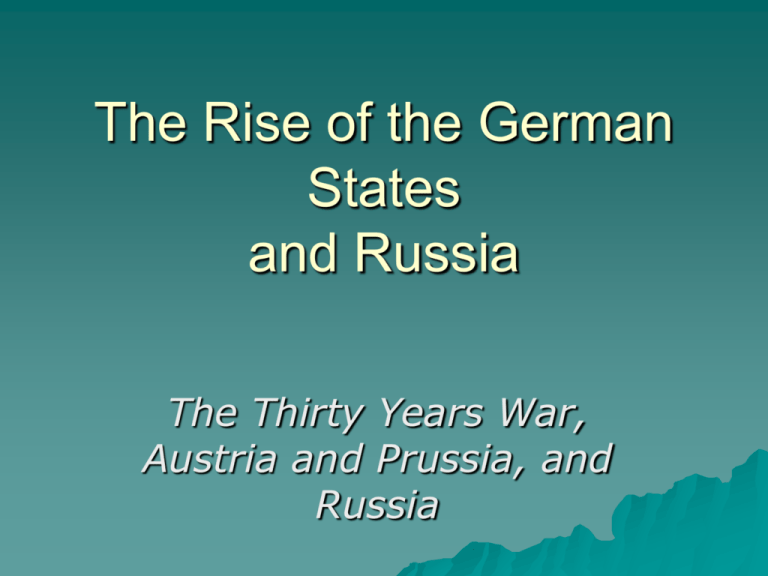
The Rise of the German States and Russia The Thirty Years War, Austria and Prussia, and Russia Thirty Years War 1618-1648 Peace of Augsburg of 1555 brought truce to warring religious factions in the Holy Roman Empire. The agreement only recognized Catholics and Lutherans (leaving out Calvinists). Calvinists began to make gains in a number or states and began demanding rights. Direct cause of the fighting was a conflict in Bohemia. Four Phases of the War Bohemian Phase (1618-1625) Danish Phase (1625-1629) Swedish Phase (1630-1635) French Phase (1635-1648) Bohemian Phase, 1618-1625 Calvinists in Bohemia concerned with the election of a Catholic King as Emperor Frederick II of the HRE. Construction of Calvinist Churches is halted. HRE is more divided by religion. The Defenestration of Prague On May 23, 1618, an assembly of Protestants tried two Imperial governors for halting the construction. They were found guilty, and thrown out of the high windows of the Bohemian Chancellery. The Defenestration of Prague They fell some 50 ft, and they landed on a large pile of manure. They all survived. Roman Catholic Imperial officials claimed that they survived due to the mercy of the benevolent angels assisting the righteousness of the Catholic cause. Protestant pamphleteers asserted that their survival had more to do with the horse excrement in which they landed than the benevolent acts of the angels. Danish Phase, 1625-1629 King Albrecht von Wallenstein Christian IV of Denmark intervened on the side of the Protestants against Ferdinand II. Albrecht von Wallenstein defeated the Danes in 1626 with a independent army of 50,000 men. Swedish Phase, 1630-1635 Swedish King Gustavus Adolphus became the new defender of the Protestant cause. In 1630, the Swedes invaded Germany. Later that year, Catholic France signed a alliance with Protestant Sweden, entering the war against the Hapsburgs. What had begun as a religious war now took political overtones. Gustavus Adolphus French Phase, 1635-1648 A settlement reached in the Treaty of Prague was wrecked by the French decision to directly intervene. Cardinal Richelieu, Chief Minister of Louis XIII wanted to weaken Hapsburg power and gain territory. Cardinal Richelieu French Phase, 1635-1648 The war continued to ravage Germany, with no side gaining the upper hand until the French became more directly involved. Ferdinand II died in 1637 and was succeeded by his son, Ferdinand III (r. 1637-1657). Peace negotiations began in 1641, but made little progress until the death of Richelieu in 1642 and the French occupation of Bavaria in 1646. Peace of Westphalia, 1648 Treaty of Westphalia ended the 30 yrs. War. France, Sweden, and Brandenburg (Prussia) gained territory. Settlement formally recognized the independence of Switzerland and Dutch Republic. Granted German states the right to make treaties and alliances, further weakening the HRE. 300+ German states became sovereign. Religious rights guaranteed in Peace of Augsburg expanded to Calvinists. Political Changes in Eastern Europe Three aging empires: gave way to new empires of Austria Prussia and Russia Holy Roman Empire: religious divisions and war in 16th and 17th century Ottoman Empire: could not maintain possessions in E. Europe and Balkans Poland: liberum veto – voting in Polish parliament had to be unanimous (= weak gov’t) The Austrian Hapsburgs Multinational empire: Austrian, Hungarian, & Bohemian kingdoms (later expansion into Slavic lands) The Austrian Hapsburgs Charles VI – Pragmatic Sanction (1713) issued by Charles VI: Habsburg territories indivisible; only Habsburgs could rule (daughter Maria Theresa) – War of Austrian Succession (17401748) – Prussia, France, Bavaria & Spain vs. Austria and Russia – Prussia tool Silesia from Austria; Prussia now most powerful German state: “Great Power” The Austrian Hapsburgs Maria Theresa (r. 1740-1780): Wars of 1740s led to internal consolidation Reduced serfdom Hohenzollerns in Prussia Frederick William, The Great Elector (r.16401688) – Rule consolidated after 30 Years’ War: military force & taxation – Junkers: nobility sided with king for stability; hereditary serfdom in 1653 – Created most efficient army in Europe Hohenzollerns in Prussia Frederick 1713) I (r. 1688- – (Elector Frederick III) “The Ostentatious” (1688-1713); 1st “King of Prussia” – Allied with Habsburgs in War of League of Augsburg and War of Spanish Succession. Hohenzollerns in Prussia Frederick William I (r. 1713-1740) “The Soldiers’ King” – Established Prussian absolutism – “Sparta of the North”: Largely a military state – best army in Europe – Junkers became officers caste in army in return for king’s absolutism Hohenzollerns in Prussia “Frederick the Great” (Frederick II: 1740-1786) of Prussia – At war for first half of his reign – Became a reformer during 2nd half of his reign – ruler was the “first servant of the state” Peter the Great in Russia Romanov Dynasty (16131917) – Michael Romanov (1613-1645) – Created Russian empire across Asia to the Pacific (largest nation by 1689) Peter the Great in Russia Peter 1725) the Great (1682- – 1698, put down revolt by strelski (Moscow Guards) – westernization (modernization): mostly for military purposes – state-regulated monopolies created; industrial serfdom – Table of Ranks: educational training for new civil service (mostly of nobles) Peter the Great in Russia St. Petersburg begun in 1703 on Baltic; largest city in Northern Europe by his death. “Winter Palace” sought to emulate Versailles. Great Northern War (1700-1721) – Fought Charles XII, 18-yr-old Swedish king – Battle of Poltava, 1709: Peter defeated Sweden Treaty of Nystad (1721): Peter

